Simon Guerrier's Blog, page 55
February 5, 2019
Scratchman, by Tom Baker
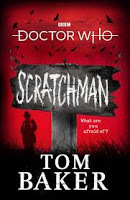 I knocked through this delicious new Doctor Who novel very quickly, revelling in its fun and invention. It's based on a movie script Tom Baker - the fourth Doctor himself - worked out with co-star Ian Marter in the 1970s. Now Baker and my mate James Goss have turned it into a novel.
I knocked through this delicious new Doctor Who novel very quickly, revelling in its fun and invention. It's based on a movie script Tom Baker - the fourth Doctor himself - worked out with co-star Ian Marter in the 1970s. Now Baker and my mate James Goss have turned it into a novel.I knew the basic story from an old feature in Doctor Who Magazine (issue #379, cover date 28 February 2007, since you weren't asking.) But the novel is a revelation, full of wit and life that didn't quite come across in a dry synopsis. Partly, that's down to the first person narration - a Doctor Who story told by the Doctor, and in more than once sense, too.
After a prologue in which the Doctor is, yet again, put on trial by his peers - here is Tom Baker reading that prologue - we start with a picnic, the Doctor playing a ukulele to the despair of his friend Sarah, while Harry is keen to play cricket on the beach. But the three friends are watched by sinister scarecrows - including the brilliant mental image of a scarecrow policeman on a bike - and the scarecrows turn out to be linked to Scratchman or, as we better know him, the Devil himself.
In the late 1970s, the proposed film had a director attached: James Hill, who'd later oversee the TV series Worzel Gummidge. I tried to imagine the events of the novel in the same bleak pastoral style, all on film, the scarecrows beautifully realised. That series terrified me as a kid because it seemed so uncannily real. (Not helped by it being shot near where I grew up.)
Scratchman's scarecrows and its depiction of ordinary, village life with its squabbling egos, would suit that kind of production. But as I read the book, I imagined it more in the style of The Android Invasion - a 1975 Doctor Who story about weird goings on in a village, a mix of location recording and studio sets. That story, the last to feature Ian Marter as Harry, is the jolliest of the stories overseen by producer Philip Hinchcliffe, the one most unlike the rest of his tenure. It was directed by his predecessor, Barry Letts, which might account for some of that. But for all the scares and deaths in Scratchman, that's the tone I felt it had. This isn't to criticise the tone - I really like The Android Invasion - but it may explain why Hinchcliffe turned down the proposal to make this for TV.
A few small things also stood out to this tragic fan. On page 92, Sarah sees a picture of herself, "posing while happily hitting her android duplicate with a lump hammer." Surely, the implication is that Scratchman is set after the events of The Android Invasion - with Harry rejoining the TARDIS for more adventures we never saw on TV. Sarah herself was in only four more stories before leaving the TARDIS, so my head has been busy trying to sort out when these new adventures of Harry fit in.
On another occasion, the Doctor lights a cigar from a monster's burning head - a macabre joke, but one that seems out of character for this particular hero. Indeed, on the 1978 story The Stones of Blood, where the Doctor faces execution, Tom Baker changed a line asking for a "last cigarette" to a "last toffee apple." Today, the "rules" about these things are carefully watched over by benign guardians at the BBC, and I imagine they - in their infinite patience and wisdom - made a special exemption here.
Elements of the story also seem familiar from things that have come after it. An awful moment where we learn the life story of one of the scarecrows just before it's destroyed reminded me of things done with the Cybermen in a couple of stories. The Doctor and his friends caught up in a giant game of pinball that then gets mixed up with chess has echoes of the first Harry Potter. Of course, this story was devised first, but we're coming to it new.
The scarecrow with the sad life story is just one of many deaths, many of them involving characters we've come to like, even if we don't always know their names. In fact, a point is made of that when the Doctor claims to remember all those who have died - a scene I thought really powerful. But the emotional impact of the book is more personal and profound. Scratchman wants to know what scares the Doctor, and for all it is played for laughs that is a penetrating question. We get a sense of what it feels like to be the Doctor, to face so much danger and terror, and to carry so much loss. That loss includes himself - the "deaths" of his former selves, and his own impending replacement. There's some fun with this - Baker can't resist a pop at his immediate predecessor not tipping a cab driver, and there's a lovely cameo by one of his future selves where this Doctor tries to be brave about his future. The trial sequence concludes setting up stuff we've since seen on TV involving his successors.
But the most powerful bit is a PS from the Doctor at the almost very end. Here, surely, is not only the Doctor ruminating on his fears, on what it's like to be him, but Tom Baker, too. He concludes with a beautiful blend of pathos and mischief, and it's hard not to think that Baker is 85. He's quite open in interviews that he's a little fragile now and might not be around too much longer. So this ending ties together the boggling ideas of the book but it also feels like goodbye. It's a perfectly judged sign-off and it completely got me. It made this broken old man cry.
Thank you, Doctor. Thanks for everything. Happy times and places to you, too.
Published on February 05, 2019 05:33
February 4, 2019
Astounding, by Alec Nevala-Lee
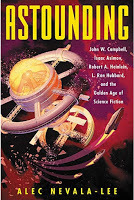 Astounding is extraordinary, a rich, incisive and constantly shocking history of the science-fiction magazine of the same name, and through it a biography of the "golden age" of SF told through the lives of four luminaries of the genre: John W Campbell, Isaac Asimov, Robert Heinlein and L Ron Hubbard.
Astounding is extraordinary, a rich, incisive and constantly shocking history of the science-fiction magazine of the same name, and through it a biography of the "golden age" of SF told through the lives of four luminaries of the genre: John W Campbell, Isaac Asimov, Robert Heinlein and L Ron Hubbard.I grew up devouring Asimov's stories and a fair bit of Heinlein, and wrote my MA dissertation on the claims made by Campbell and others about the quality - and value - of "real" science in SF. That was all a long time ago, but I thought I knew this story. Not a bit of it, it turns out. And some of my heroes were appalling people.
I'm going to write more about that in a review for someone else, so I'll be brief here. I really admired how Nevala-Lee involves women whose voices have otherwise been lost, reminding us of their presence and underlining their influence. Kay Tarrant, for example, was always at the next desk from Campbell when authors came to visit, so would have had a ring-side view of many of the battles described here. When she had a heart attack, we're told, it took five people to carry out the tasks she'd quietly got on with for decades. We get just an impression of her, but it's a strong one, and important.
The book is also unflinching about the shortcomings of authors - not just the four main subjects - and their sometimes downright awful behaviour. "Asimov, who described himself as a feminist, casually groped female fans for years," we're told (p. 12) - and he's the one who comes off best. But there's effort to understand if not condone them, and we can also glory in their work and their influence.
It's prompted me to read a bunch of Asimov's robot stories again, and I remembered robopsychologist Susan Calvin as a pioneering character - a competent, professional woman getting on with her high-level job. But I think that view must have come from Asimov himself, introducing the stories in his jokey, self-effacing way - as he remarks on his own progressive brilliance,
"You will note, by the way, that although most of the Susan Calvin stories were written at a time when male chauvinism was taken for granted in science fiction, Susan asks no favors and beats the men at their own game. To be sure, she remains sexually unfulfilled - but you can't have everything." - Isaac Asimov, The Complete Robot, p. 327.I'm keen to look again at Heinlein, and have been eyeing The Pleasant Profession of Robert A Heinlein by my friend Farah Mendlesohn, perhaps (as a kind tweeter advised) after a read of the Expanded Universe collection.
Published on February 04, 2019 10:48
February 1, 2019
Pick of the Week in Radio Times
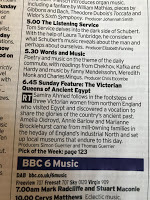 Excitingly, listings magazine Radio Times has chosen our documentary,
Victorian Queens of Ancient Egypt
(this Sunday, 6.45pm, Radio 3), as its pick of the week.
Excitingly, listings magazine Radio Times has chosen our documentary,
Victorian Queens of Ancient Egypt
(this Sunday, 6.45pm, Radio 3), as its pick of the week.Bolton Council also has a piece on the documentary: "BBC to highlight Bolton's museum benefactor."
Published on February 01, 2019 01:22
January 22, 2019
The Tiger's Wife by Tea Obreht
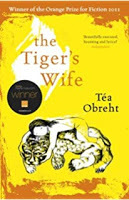 This strange, beguiling novel tells many stories. Natalia is a doctor working in the Balkans in the aftermath of years of war. She learns her grandfather - also a doctor - has died in peculiar circumstances, and in trying to investigate what happened we learn about their time together, and his past. That includes his meetings with a man who cannot die, and childhood experience with a deaf-mute woman known as the Tiger's Wife. We unpick the lives of peripheral characters along the way.
This strange, beguiling novel tells many stories. Natalia is a doctor working in the Balkans in the aftermath of years of war. She learns her grandfather - also a doctor - has died in peculiar circumstances, and in trying to investigate what happened we learn about their time together, and his past. That includes his meetings with a man who cannot die, and childhood experience with a deaf-mute woman known as the Tiger's Wife. We unpick the lives of peripheral characters along the way.It's beautifully written and full of striking imagery. I find myself lingering over particular moments: Natalia and her grandfather following an elephant as it is escorted through town, or Natalia spraying water at her family's holiday home while a wildfire gets ever closer. The sequences with the Deathless Man are brilliantly creepy - at one point, we discover him walled up in the basement of a church, calmly pointing out which of the other people there will not survive the night.
For all the fantasy elements, the real horror is from ordinary people - their cruelty and indifference, the suffering they inflict. Luka, for example, abuses his wife and when he then vanishes people assume he's been murdered - and don't really seem to mind. But we also follow the thread of his life to understand why he is violent. It doesn't condone his actions, or make them any less appalling.
The fate of an apothecary, told right at the end of the book, is the most potent example of what can happen when a country turns on itself and anyone thought of as "foreign". It felt depressingly timely. And then his story concludes by almost casually mentioning the fate of the Tiger's Wife, which is devastating.
One puzzling thing: on the cover, a header proclaims, "Winner of the Orange Prize for Fiction 2011". There's then also a sticker proclaiming the same thing.
Published on January 22, 2019 01:00
January 21, 2019
Victorian Queens of Ancient Egypt
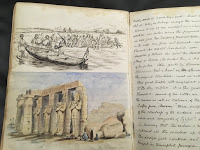 Marianne Brocklehurst's diaryVictorian Queens of Ancient Egypt, my fourth documentary for Radio 3's Sunday Feature will be broadcast on 3 February. This morning, presenter Samira Ahmed is in the Guardian about it:
Marianne Brocklehurst's diaryVictorian Queens of Ancient Egypt, my fourth documentary for Radio 3's Sunday Feature will be broadcast on 3 February. This morning, presenter Samira Ahmed is in the Guardian about it:Guardian: "The lure of ancient Egypt is a way to revitalise faded industrial towns"
There are details for the programme on the BBC website:
Samira Ahmed explores the profound connection between ancient Egypt and the Victorian heyday of Britain’s industrial north – in a legacy of museums and northern pride.
Being taken to see the mummies has become a rite of passage, captivating generations of children since the late 19th century. Ancient Egypt is now embedded in early years education. At more than a hundred museums across the UK, that culture helps shape the British imagination. Where did that affinity come from?
To find out, Samira follows in the footsteps of three extraordinary women: Amelia Oldroyd, Annie Barlow and Marianne Brocklehurst. Each came from a northern, mill-owning family, and each felt compelled not only to visit Egypt and to collect antiquities, but to share their treasures with those at home. Each established local museums that survive today, inspiring new generations.
Today, such museums face an uncertain future. By returning to these women’s stories, can lessons be learned from the past?
Contributors:
Katina Bill, Kirklees Museums and Galleries
Matthew Watson and Rizwana Khalique, Bolton Library and Museum Services
Danielle Wootton
Emma Anderson and Kathryn Warburton, Macclesfield Museums
Rebecca Holt, MPhil student at Oxford University
Heba abd al-Gawad, Egyptian Egyptologist
Alice Stevenson, Institute of Archaeology, UCL
Dr Chris Naunton
Producers: Simon and Thomas Guerrier
A Whistledown Production for BBC Radio 4
Published on January 21, 2019 02:57
January 7, 2019
Christel & Simon Talk Doctor Who
Here's an interview with me and Christel Dee about our book, Doctor Who - The Women Who Lived, conducted at Forbidden Planet in London. It includes glimpses of the book and of some of the brilliant artists. And if you look very carefully, you can spot out loitering boss.
Published on January 07, 2019 06:01
December 23, 2018
The Story of Rose Tyler
Here's another video entry from our book, Doctor Who - The Women Who Lived, this time telling the story of the Doctor's friend Rose Tyler. The new artwork is by Mogamoka, Cat Zhu, Tammy Taylor, Katy Shuttleworth, Natalie Smilie, Sophie Cowdry, Jo Be and Kate Holden.
Published on December 23, 2018 02:02
December 21, 2018
Edward Lear - Egyptian Sketches, by Jenny Gaschke
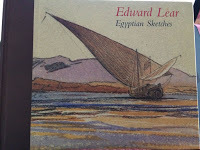 Edward Lear - Egyptian Sketches
Edward Lear - Egyptian Sketchesby Jenny GaschkeHaving finished the biography of Lear, I had another look at this collection published by the National Maritime Museum in 2009, collating sketches from two trips Lear made down the Nile in 1853-4 and 1866-7.
It's a beautiful book, full of beautiful images, presented in sequence according to Lear's own numbering system so we can follow him on his journeys.
As Gaschke tells us, Lear - like many of his contemporaries - was interested in the picturesque and historical, and ignored signs of modernisation such as the new steam-powered boats. Instead, there are lots of sailed boats sitting quietly on the water, serene and bewitching. (I'm glad to see sketches of the dahabeeh he travelled on - the same kind of vessel hired by Marianne Brocklehurst in the 1870s, about which I'm making a documentary.)
Nor does he depict his travelling companions, and few of the pictures presented here show the famous monuments. Gaschke is good at underlining what makes his images different from those of others, such as the well known lithographs of David Roberts (1796-1864).
"While closely documenting architectural and natural detail, these (published) drawings were also highly appreciated at the time as aesthetic expressions of the sublime, beautiful and picturesque. Roberts laid emphasis on the exotic, the 'oriental' aspects of everyday life in Egypt, with warm lighting and adoption of dramatic viewpoints, for example from far below, to stylise the monumental remains of ancient temples." (p. 20).Lear's images, by contrast, often place ruins at a distance, in outline, even partly obscured by foreground "rox" or trees. Without the low viewpoint, they are smaller, part of wider, sand-swept landscape.
Published on December 21, 2018 04:33
December 20, 2018
Mr Lear – A Life of Art and Nonsense, by Jenny Uglow
This exhaustive account of the life of Edward Lear (1812-88) is a great delight. I’ve been a fan of Lear since seeing his sketches on the walls of the Benaki Museum in Athens in my earliest travels with the Dr. They’re beautiful, briskly drawn things, conjuring a view, a feeling, in just a few lines and annotated with detail for when he came to paint his (to my mind less interesting) full versions in oil. When the Dr and I married in 2004 we chose “The Owl and the Pussycat” as a reading.“Lear’s great poems and songs are not about his life – they float free. But their gaiety and sadness feel even keener when set against the tensions he saw, and suffered” (Uglow, p. 380).
The most famous of Lear’s nonsense poems, was – Uglow tells us – written on 18 December 1867, for a troubled young girl called Janet Symonds whose father seemed less interested in Janet’s mother than in publishing his Problems of Greek Ethics, in which he sought to show that,
“what the Greeks called paiderastia or boy-love, was a phenomenon of one of the most brilliant periods of human culture” (quoted in Uglow, p. 377).Lear was also gay, Uglow tells us, shrewdly sifting the evidence when nothing could quite be admitted to. It was part of his reason for constant restlessness and travel; perhaps it informed the gender of the pussycat and owl. His 30-year relationship with his servant, Giorgio, is rather moving - and ends with quite twist.
Uglow tells Lear's story through impeccable research, from his early days at Knowsley illustrating exotic animals and birds to his last, quiet days in Villa Tennyson, the house he had built in San Remo. He is a funny, kind and rather sad man and its a pleasure to accompany him throughout the world - just as his friends enjoyed his company. Despite my better judgment, I laughed at many of his old jokes, such as this one included in at letter to his friend Chichester Fortescue on 16 August 1863:
“What would Neptune say if they deprived him of the sea? I haven’t a n/otion.” (p. 265).Lear wrote a lot - letters, diaries, even on his sketches. But where direct sources are missing Uglow quotes from others who were in the same place at around the same time, or whose comments can inform. In fact, the book is full of other people. I was drawn to Lear's friendship with Frances Waldegrave (1821-79), the "dazzling hostess" of Strawberry Hill whose various husbands Uglow dashes through on page 229, adding,
"Trollope allegedly used her as the model for Madame Max Goesler in his Palliser novels."We learn to love her as Lear did, and her death - in a book where everyone is long dead - comes as a terrible shock.
Another extraordinary character is Charlotte Cushman (1816-76), a stage actress and contralto living in Rome "with her current lover, the sculptor Harriet 'Harry' Hosmer". Lear attended an evening she hosted on 28 January 1859, and Uglow quotes a letter from another attendee, US sculptor William Wetmore Story, to reconjure the "harem" and these "emancipated ladies":
“The Cushman sings savage ballads in a hoarsey, many voice, and requests people recitatively to forget her not. I’m sure I shall not.” (in Uglow, p. 276.)If Lear's diary doesn't provide insight on that particular night, Uglow quotes his entry of 9 May the same year:
"Lear was astounded when the Prince of Wales commissioned one of her sculptures: ‘& one from Hosmer!!!!!!!!!!!!’”For all the exclamation marks, Lear returned to Cushman's for dinner in March 1860, where,
“the other guests were her new partner the sculptor Emma Stebbins, the diplomat Odo Russell … the archaeologist Charles Newton [the subject of the Dr's PhD]… and Robert Browning" (p. 281).Or there's Gussie - Augusta Bethell Parker - the young, sweet girl who Lear kept thinking he'd marry and then thinking he would not. She might be the passive victim of his indecision and insecurities, had we not been told the first time we met her (on page 343) that Gussie was also author of Maud Latimer (1863), a novel about a naughty, adventurous heroine that suggests a more thrilling inner life.
There is plenty of name-dropping, not all of it because Lear was himself famous. On page 105, Uglow tells us that the young Lear had lodgings at 36 Great Malborough Street in London at the same time as Charles Darwin, who'd just completed his trip on the Beagle, and asks, "did they pass on the stairs?" But nor is it all celebrity encounters. Uglow notes, in brackets, a fun detail about protestant tourists attending mass at the Vatican.
"a few years later English ladies gained a reputation for whispering and eating biscuits, and the Vatican sent round a notice asking for decorum in Holy Week" (p. 114).She is brilliant at following a thread. In noting, on page 253, Lear's horror at bigotry, she guides us through the religious debates of the day - in response only partly to Darwin. David Friedrich Strauss’s three volume The Life of Jesus, first published in the mid-1830s, set aside the supernatural to see Jesus as a historical figure, while Ludwig Feuerbach’s The Essence of Christianity (1841) stressed sympathy and love over vengeful justice. Both were translated into English by Mary Ann Evans (later George Elliot) - in 1846 and 1854 respectively.
She returns to this thread sometime later, in chapter 25 - titled "'Overconstrained to Folly': Nonsense, 1861". I wasn’t sure about Uglow’s earlier close reading of the first edition of Lear's book of nonsense, for all it helps explain the enduring appeal.
“The rhymes, ‘Hairy! Beary! Taky cary!’ or ‘mousey, bousey, sousey’, were the kind of nonsense words that parents speak to babies, often the first words they hear, and all the more alluring – and important – for that reason” (p. 264).But when she returns to this close analysis for the second, revised edition of his book, the differences suggest Lear's changing character and mindset. It is brilliantly done. Then she moves straight into religion, and Darwin and the more pertinent Essays and Reviews, which caused a furore by seeing Jesus historically and doubting the truth of the miracles. It seemed a bit crass to link this to Lear's nonsense - but that's exactly what Lear does himself, addressing the debates in a letter to Lady Waldegrave on 15 March 1863:
"I begin to be vastly weary of hearing people talk nonsense, - unanswered – not because they are unanswerable but because they talk from pulpits” (p. 309).Who better than Lear to spot nonsense?
That's what so brilliant about this book: it doesn't bridge the nonsense books with Lear's career as a painter; there is no separation between these parts of him. Insecurties - his sexuality, his epilepsy - fed his travels and his nonsense; his travel informed his nonsense; especially in his later life, his travels were aided by the fame of and delight in his nonsense.
Published on December 20, 2018 08:44
December 14, 2018
The Story of Susan Foreman
That splendid lot at BBC Studios have produced this lovely video telling the story of Doctor Who's granddaughter, Susan Foreman.
The text is by me and Christel Dee, from our book The Women Who Lived, but there are all new illustrations by Lara Pickle, Dani Jones, Caz Zhu, Mogamoka, Rachael Smith, Kate Holden, Sonia Leong and Gwen Burns. Hooray!
The text is by me and Christel Dee, from our book The Women Who Lived, but there are all new illustrations by Lara Pickle, Dani Jones, Caz Zhu, Mogamoka, Rachael Smith, Kate Holden, Sonia Leong and Gwen Burns. Hooray!
Published on December 14, 2018 04:27
Simon Guerrier's Blog
- Simon Guerrier's profile
- 60 followers
Simon Guerrier isn't a Goodreads Author
(yet),
but they
do have a blog,
so here are some recent posts imported from
their feed.



